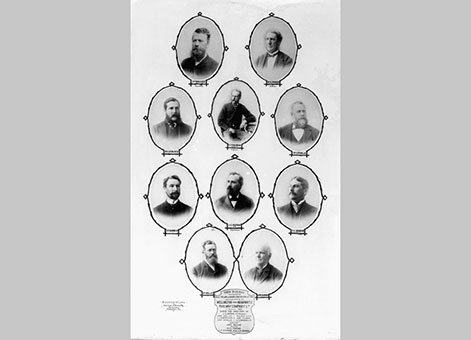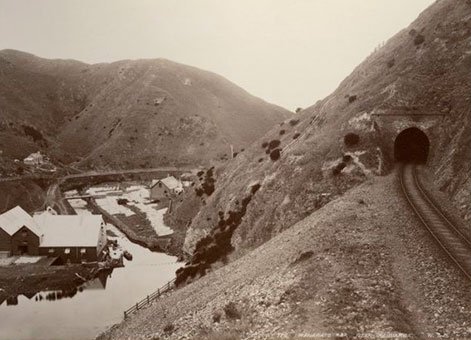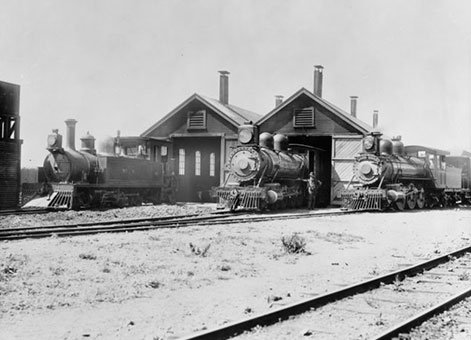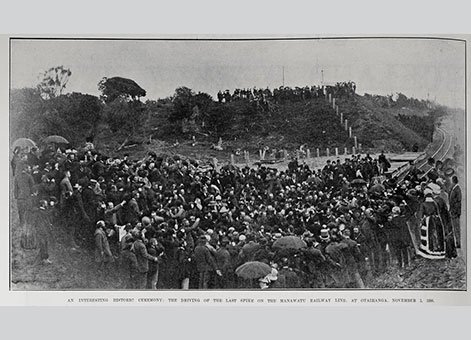Although initially a government project in 1879, the Wellington and Manawatū Railway (WMR) was completed by a company between 1881 and 1886. This was a very successful private railway before being integrated into the government system in 1908.

Directors of the Wellington-Manawatū Railway Company. S P Andrew Ltd: Portrait negatives. Ref: 1/1-015058-G. Alexander Turnbull Library, Wellington, New Zealand.
A false start and the creation of the Wellington and Manawatū Railway Company
Julius Vogel's (1835–1899) 1870 scheme for immigration and public works envisaged a railway up Wellington’s west coast to the Manawatū. However, it was not begun (starting at the Wellington end) until 1879. Later that year government loans funding dried up in the aftermath of the collapse of the City Bank of Glasgow, and stopped formation construction between the suburbs of Thorndon and Khandallah.
The Wellington Chamber of Commerce, disappointed at the commercial outcomes of the opening of the railway to Masterton, pressed for continuation of this west coast line’s construction. Negotiations between the Government and the Chamber resulted in the Government offering land and railway works already available. Other terms included land grants being progressively made to the private company constructing the railway. The sale of this land would enable the company to off-set construction costs. In return the company could sell the completed line to the government either on completion, or at any time up to 21 years after its completion. These negotiations lead to the Wellington and Manawatū Railway Company forming in 1880.

Ngaio Gorge, showing Schultze's dam on the Kaiwharawhara Stream, and No 2 tunnel of the Wellington and Manawatū Railway [between 1885 and 1888]. Alexander Turnbull Library, Wellington, New Zealand.
Constructing and operating the private railway
With the establishment of the Company, work on constructing the WMR was able to resume in 1881. The railway would eventually connect with the existing government railway at Longburn, near Palmerston North. The project involved some important New Zealand engineers, including Harry Higginson and James Edward Fulton.
The first section, from Thorndon to Paekakariki (via Johnsonville and Porirua) crossed mountainous terrain, which made it particularly challenging. The remaining longer section of the route northward was characterised by a combination of firm ground and peat swamps.
The last spike was driven at Otaihanga, Paraparaumu on 3 November 1886. At the time of its completion, the Government declined to buy the railway because New Zealand was still in the depths of an economic depression and there were no spare funds. The Company had not anticipated this and unexpectedly had to continue on and operate the line. However, they did this astutely and it became the country's most successful privately owned railway. The first dividend was paid in 1891, and from 1904 the Company declared the maximum annual dividend allowed under its empowering Act of Parliament, which was seven per cent.
Operating rules and procedures developed in the United States of America were adopted in preference to those of the government railways which were derived from British practice. The WMR was very progressive, for example telephones were used for communications along the line and guard vans carried hook-up earth return telephones for emergency use. Passenger carriages were electronically lit from 1895.

Wellington and Manawatū Railway bridge over Waikanae river [between 1885 and 1888]. Levin, William Hort, 1845-1893: Wellington and Manawatū Railway Company Ltd: Views on the Wellington & Manawatū Railway. Ref: PA1-f-239-13. Alexander Turnbull Library, Wellington, New Zealand.
Changes to the railway
With the construction of the North Island Main Trunk Railway to Auckland nearing completion towards the end of 1907, the government served notice of its intention to exercise its option to buy the WMR with effect from 7 December 1908.
The original composite timber and steel WMR bridges were mostly replaced in the late 1930s by steel and concrete bridges in order to accommodate increasingly large locomotives and trains. The last of these to be replaced was over the Manawatū River at Longburn in 1958.
The tunnels are original structures, although the coastal ones south of Paekakariki have had successive modifications to lower floor levels and improve clearances for larger rolling stock and successively taller container boxes. The Johnsonville Branch tunnels had their floors lowered 0.8 metres in January 2009 as part of a general reconstruction of the line in preparation for the planned introduction of new electric multiple unit trains late in 2010.

Three Wellington and Manawatū Railway locomotives outside railway sheds [before 1908]. Godber, Albert Percy, 1875-1949: Collection of albums, prints and negatives. Ref: APG-1131-1/2-F. Alexander Turnbull Library, Wellington, New Zealand.
The Wellington-Johnsonville section was electrified at 1,500 volts direct current in 1938, for operation by two-car electric multiple unit trains. All signalling is fully automatic, including train crossings on this single line mountain railway. Maximum gradient up the Ngaio Gorge is 1 in 41. It is marketed as a tourist attraction as well as a commuter route. There are spectacular views of Wellington’s suburbia clinging to the hillsides and of the harbour.
The descent to sea level north of the summit at Johnsonville was closed in 1938 after the double-track Tawa Flat diversion came into use, which included two major tunnels. The land formerly used for the railway was incorporated into a suburban street and State Highway 1.
The main line to Paekakariki was electrified in 1940. Electrification was extended to Paraparaumu in 1983. There is an intensive electric suburban train service. In response to community demand to extend this service further northward, work is in hand (2014) to extend the track duplication and electrification to Waikanae, the next town north.
Three complete WMR carriages still exist, two of which are undergoing restoration to their original condition at Silverstream, Hutt Valley. Remarkably, they were built in 1906 using wood recycled from a timber trestle viaduct at Johnsonville that was replaced with a steel structure. The bones of one 2-6-2 locomotive built in 1891 are at Steam Incorporated, Paekakariki, where there is a long-term project to recreate a working locomotive.

An interesting historic ceremony: The driving of the last spike on the Manawatū Railway line, at Otaihanga, November 3, 1886. Sir George Grey Special Collections, Auckland Libraries, AWNS-19080924-2-1.
More information
New Zealand Archaeological Association
Part of the site is in the New Zealand Archaeological Association Site Record as site R27/536. See ARCHSITE
Access
Readily accessible by rail on scheduled passenger trains which travel the whole route. The railway is also visible from the road. State highway 1 closely parallels it and other local roads give access at many points.
References
K R Cassells, ‘Uncommon Carrier,’ New Zealand Railway & Locomotive Society, Wellington, 1994.
Rob Merrifield,‘ An Exercise in Large Scale Joinery: Restoration of Three Historic Wellington & Manawatu Railway Carriages,’ paper presented at the 4th Australasian Engineering Heritage Conference (2014).
Location
From Wellington (Thorndon) to Longburn, near Palmerston North, Manawatū.

